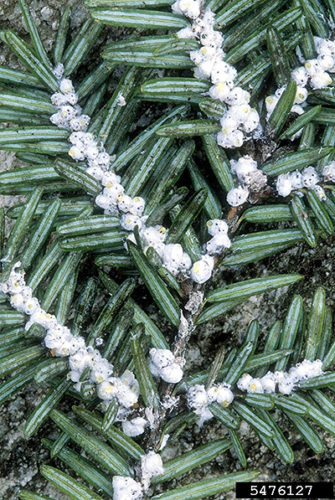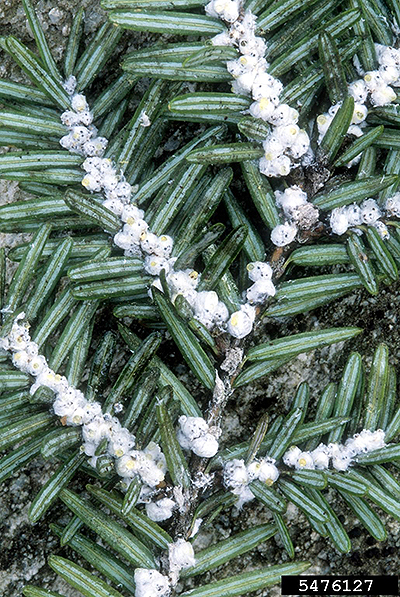
In the 1950s a particularly nasty invasive insect called the hemlock wooly adelgid (HWA) arrived in the U.S. on infested ornamental hemlock trees. This insect feeds on the sap of hemlock trees (Tsuga sp.). The American species (Eastern and Carolina hemlocks) have no defense against this invasive pest and will eventually die. Hemlocks are slow growing and very long lived trees.
Hemlock is a vital component of the New England forest system, and is the third-most prevalent tree in Vermont. It provides protection from erosion along stream banks, food for deer and wildlife, and shelter for deer in winter. The tree is also valued both as an ornamental and as an important source of lumber. Reports of decimation to hemlock forests are coming in from all along the Appalachians and 17 north-eastern states stretching from the Smoky Mountains to southern Maine.
The hemlock wooly adelgid (Adelges tsugae) looks like white clumps on the undersides of branches of hemlocks. Each fluffy spot is actually a group of aphid-like insects covered by a white wax that protects them from predators.
Symptoms of infestation include yellow, chlorotic needles or needle loss, loss of tree vigor and dead branches. Chlorosis is a condition in which leaves produce insufficient chlorophyll.
Hemlock wooly adelgid is a relatively slow killer and may take up to ten years before a tree succumbs. There are several control options that contain the systemic insecticides imidacloprid and azadirachtin for larger trees, insecticidal soap or dormant/horticultural oil for trees where the whole canopy is accessible. Carefully follow directions on the label.
The environmentally safest chemical control methods for treating individual trees are nontoxic insecticidal soap and horticultural oil. These are sprayed on the foliage and smother the insects as they dry. Most trees need to be treated on a yearly basis.
Loss of the eastern and Carolina hemlock from hemlock woolly adlegid infestation will likely result in many ecological shifts in eastern North America. The understory of hemlock forests is characterized as dark, damp, and cool and is an ideal habitat for various other organisms. The moist environment is preferred by many native amphibian species, particularly newts and salamanders. Some species of birds have close association with the hemlock, especially during mating and nesting periods. Aquatic systems adjunct to hemlock stands are also affected by the trees’ decline. Brook trout is a native fish species to the eastern United States and is known to prefer the cool, shaded streams of hemlock forests during spawning events. Vulnerable animal populations are expected to diminish as a result of loss of hemlock habitat to the invasive HWA.
One factor giving hope is that the adelgid does not seem able to survive prolonged or bitter cold. Following the winter of 1999-2000, a considerable dieback of adelgids and subsequent regrowth of infested trees was observed across Connecticut. The same phenomenon was repeated after the prolonged winter of 2013-2014, in time to save numerous nearly succumbed forests.

